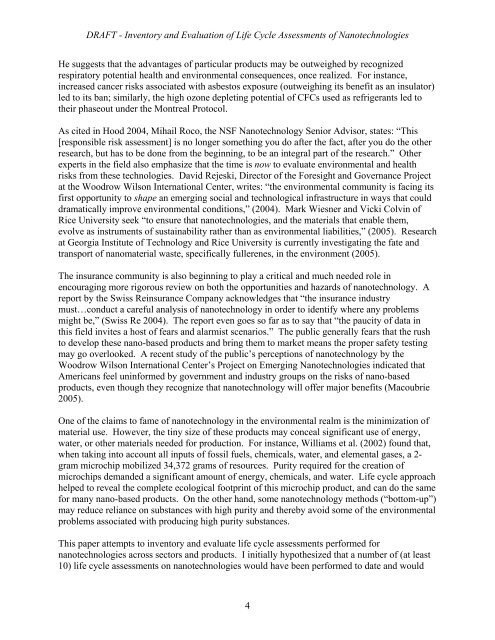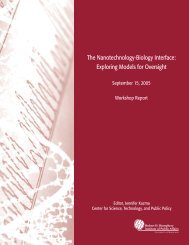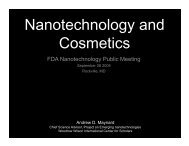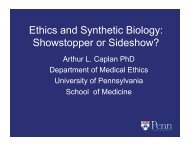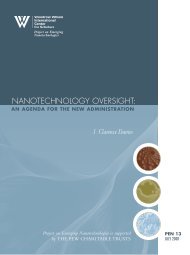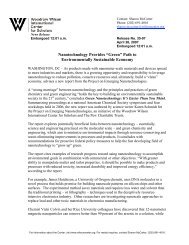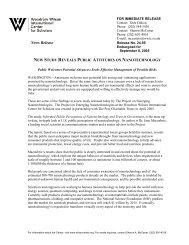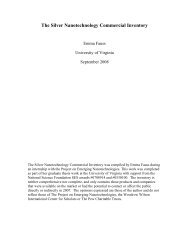Analysis of Nanotechnology from an Industrial Ecology ... - denix
Analysis of Nanotechnology from an Industrial Ecology ... - denix
Analysis of Nanotechnology from an Industrial Ecology ... - denix
You also want an ePaper? Increase the reach of your titles
YUMPU automatically turns print PDFs into web optimized ePapers that Google loves.
DRAFT - Inventory <strong>an</strong>d Evaluation <strong>of</strong> Life Cycle Assessments <strong>of</strong> N<strong>an</strong>otechnologies<br />
He suggests that the adv<strong>an</strong>tages <strong>of</strong> particular products may be outweighed by recognized<br />
respiratory potential health <strong>an</strong>d environmental consequences, once realized. For inst<strong>an</strong>ce,<br />
increased c<strong>an</strong>cer risks associated with asbestos exposure (outweighing its benefit as <strong>an</strong> insulator)<br />
led to its b<strong>an</strong>; similarly, the high ozone depleting potential <strong>of</strong> CFCs used as refriger<strong>an</strong>ts led to<br />
their phaseout under the Montreal Protocol.<br />
As cited in Hood 2004, Mihail Roco, the NSF <strong>N<strong>an</strong>otechnology</strong> Senior Advisor, states: “This<br />
[responsible risk assessment] is no longer something you do after the fact, after you do the other<br />
research, but has to be done <strong>from</strong> the beginning, to be <strong>an</strong> integral part <strong>of</strong> the research.” Other<br />
experts in the field also emphasize that the time is now to evaluate environmental <strong>an</strong>d health<br />
risks <strong>from</strong> these technologies. David Rejeski, Director <strong>of</strong> the Foresight <strong>an</strong>d Govern<strong>an</strong>ce Project<br />
at the Woodrow Wilson International Center, writes: “the environmental community is facing its<br />
first opportunity to shape <strong>an</strong> emerging social <strong>an</strong>d technological infrastructure in ways that could<br />
dramatically improve environmental conditions,” (2004). Mark Wiesner <strong>an</strong>d Vicki Colvin <strong>of</strong><br />
Rice University seek “to ensure that n<strong>an</strong>otechnologies, <strong>an</strong>d the materials that enable them,<br />
evolve as instruments <strong>of</strong> sustainability rather th<strong>an</strong> as environmental liabilities,” (2005). Research<br />
at Georgia Institute <strong>of</strong> Technology <strong>an</strong>d Rice University is currently investigating the fate <strong>an</strong>d<br />
tr<strong>an</strong>sport <strong>of</strong> n<strong>an</strong>omaterial waste, specifically fullerenes, in the environment (2005).<br />
The insur<strong>an</strong>ce community is also beginning to play a critical <strong>an</strong>d much needed role in<br />
encouraging more rigorous review on both the opportunities <strong>an</strong>d hazards <strong>of</strong> n<strong>an</strong>otechnology. A<br />
report by the Swiss Reinsur<strong>an</strong>ce Comp<strong>an</strong>y acknowledges that “the insur<strong>an</strong>ce industry<br />
must…conduct a careful <strong>an</strong>alysis <strong>of</strong> n<strong>an</strong>otechnology in order to identify where <strong>an</strong>y problems<br />
might be,” (Swiss Re 2004). The report even goes so far as to say that “the paucity <strong>of</strong> data in<br />
this field invites a host <strong>of</strong> fears <strong>an</strong>d alarmist scenarios.” The public generally fears that the rush<br />
to develop these n<strong>an</strong>o-based products <strong>an</strong>d bring them to market me<strong>an</strong>s the proper safety testing<br />
may go overlooked. A recent study <strong>of</strong> the public’s perceptions <strong>of</strong> n<strong>an</strong>otechnology by the<br />
Woodrow Wilson International Center’s Project on Emerging N<strong>an</strong>otechnologies indicated that<br />
Americ<strong>an</strong>s feel uninformed by government <strong>an</strong>d industry groups on the risks <strong>of</strong> n<strong>an</strong>o-based<br />
products, even though they recognize that n<strong>an</strong>otechnology will <strong>of</strong>fer major benefits (Macoubrie<br />
2005).<br />
One <strong>of</strong> the claims to fame <strong>of</strong> n<strong>an</strong>otechnology in the environmental realm is the minimization <strong>of</strong><br />
material use. However, the tiny size <strong>of</strong> these products may conceal signific<strong>an</strong>t use <strong>of</strong> energy,<br />
water, or other materials needed for production. For inst<strong>an</strong>ce, Williams et al. (2002) found that,<br />
when taking into account all inputs <strong>of</strong> fossil fuels, chemicals, water, <strong>an</strong>d elemental gases, a 2-<br />
gram microchip mobilized 34,372 grams <strong>of</strong> resources. Purity required for the creation <strong>of</strong><br />
microchips dem<strong>an</strong>ded a signific<strong>an</strong>t amount <strong>of</strong> energy, chemicals, <strong>an</strong>d water. Life cycle approach<br />
helped to reveal the complete ecological footprint <strong>of</strong> this microchip product, <strong>an</strong>d c<strong>an</strong> do the same<br />
for m<strong>an</strong>y n<strong>an</strong>o-based products. On the other h<strong>an</strong>d, some n<strong>an</strong>otechnology methods (“bottom-up”)<br />
may reduce reli<strong>an</strong>ce on subst<strong>an</strong>ces with high purity <strong>an</strong>d thereby avoid some <strong>of</strong> the environmental<br />
problems associated with producing high purity subst<strong>an</strong>ces.<br />
This paper attempts to inventory <strong>an</strong>d evaluate life cycle assessments performed for<br />
n<strong>an</strong>otechnologies across sectors <strong>an</strong>d products. I initially hypothesized that a number <strong>of</strong> (at least<br />
10) life cycle assessments on n<strong>an</strong>otechnologies would have been performed to date <strong>an</strong>d would<br />
4


